Jennifer Kloester's Blog, page 6
January 1, 2021
2021 – Georgette Heyer’s Centenary Year!
A very Happy New Year everyone and to Heyer readers everywhere! 2021 marks the hundredth anniversary of Georgette Heyer’s first novel, The Black Moth. Written when she was just seventeen and published in September 1921, just a month after her nineteenth birthday, this remarkable teenage novel is still in print and continues to entertain readers around the world. This year will be the first centenary celebration and we are planning a Heyer Convention to mark the occasion – more on that as the date and details firm up.
 Georgette Heyer about the time of writing The Black Moth
Georgette Heyer about the time of writing The Black Moth The 1929 Heinemann editionThe Black Moth was a remarkable achievement for such a young writer.
The 1929 Heinemann editionThe Black Moth was a remarkable achievement for such a young writer.Times change but great storytelling endures
The world in 2021 is a very different place from the one Georgette Heyer knew. Born an Edwardian and raised by Victorian parents when Britain was the ruler of a vast empire, she grew up believing in a social hierarchy based on birth, race and creed. Today, many of the ideas and attitudes which Heyer and her peers took for granted are being rejected en masse and in many places discarded and replaced with far more inclusive ideologies. This is a good thing. But it also means that there are things to discuss about Georgette Heyer and the beliefs which she and many of her literary peers held – beliefs that are no longer acceptable to a tolerant society but which are at times reflected in their books. I believe it is important to be able to discuss these things calmly, honestly and openly and I look forward to writing about them at greater length in some of the blogs to come in 2021. Much has changed in the one hundred years since Georgette Heyer published her first novel, bu no matter how much changes in the world, one thing that has endured from the beginning of human history, and that is our love of great storytelling.
 HappyRachel Hyland’s hugely entertaining Reading Heyer The Black Moth
HappyRachel Hyland’s hugely entertaining Reading Heyer The Black Moth Happy New Year everyone and may 2021 be a better year for all!
December 22, 2020
Georgette and the Christmas gift
Georgette always enjoyed Christmas and was a generous giver of gifts to family and friends. Her favourite shopping destination for Christmas gifts was Fortnum and Mason, the famous department store that was literally across the road from her home in Albany. Fortnums, as it is affectionately called, is on Piccadilly in the heart of London and is famous for its magnificent food hall. Each Christmas Georgette would visit Fortnums and order sumptuous Christmas hampers for her brothers, her brother-in-law and his wife, her nephews, cousins, and several fortunate friends. The hampers were luxurious, filled to the brim with delicious goodies and often with a bottle of champagne to celebrate the season. For the lucky recipients those glorious hampers from Fortnum and Mason remained memorable long after the last morsel was eaten and the last drop drunk!
 Georgette loved Fortnum and Mason – this is the famous Piccadilly store lit up to look like an Advent Calendar. (photo by KWH 1050)
Georgette loved Fortnum and Mason – this is the famous Piccadilly store lit up to look like an Advent Calendar. (photo by KWH 1050)A chinchilla Christmas!
In a recent Weekly Post for the International Heyer Society I offered this delightfull letter from Georgette written a week after her Christmas celebration in 1970. As a Christmas gift to Heyer fans everywhere, I thought I’d share it with you on this special day.
Christmas 1970 proved a memorable celebration for Georgette and her family. Her only child, Richard, was now a successful barrister and married with two young stepsons, Dominic and Noel, and a son of his own, Nicholas. A week after Christmas Georgette couldn’t resist sharing a delightful Christmas story and wrote to her agent, Joyce Wiener, to tell her about their adventure with a chinchilla!
2 January 1971
 Malene Thyssen, http://commons.wikimedia.org/wiki/User:Malene
Malene Thyssen, http://commons.wikimedia.org/wiki/User:Malene
Dear Joyce,
[…] Christmas was enlivened by the introduction into the household of Richard’s present to his younger stepson, Noel, which was a baby chinchilla! A most entrancing little creature, which cast Noel into speechless ecstasies. It also provided Richard, Dominic, and me with a very nerve-racking hour, trying to catch it, and to put it into its hutch, what time Susie and her mother kept Noel occupied at the other end of the house! Richard and Dommy drove into Ledbury on Christmas Eve to collect it, and its hutch was placed, temporarily, in Richard’s study. Unfortunately, none of us three had realized the extraordinary agility of chinchillas! Richard cautiously opened its travelling-box, expecting it to go straight into the hutch, but instead of doing this it leapt over Richard’s hands, and defied capture for over an hour! My job was to guard the door against intruders, so that no one coming in should allow Sidney, the cat, to come in too! The poor little thing was quite unnerved by the unprecedented events of the day, of course. Its final refuge was behind the curtains which hang in front of Richard’s very heavy desk, whence it made Distressful Noises, what time Richard and Dominic lay on their tummies, trying to cajole it into emerging! It was Susie who finally caught it, and put it into its hutch, where it very soon settled down, and, with perfect sangfroid, took a raisin out of Richard’s fingers! When I left, it was rapidly developing into an enchanting pet, and Dominic, who is a good carpenter, was making two more hutches for it – one for travel, and the other for its London residence! I hope 1971 [and 50 years later, 2021] will be a better year for you, and will end with
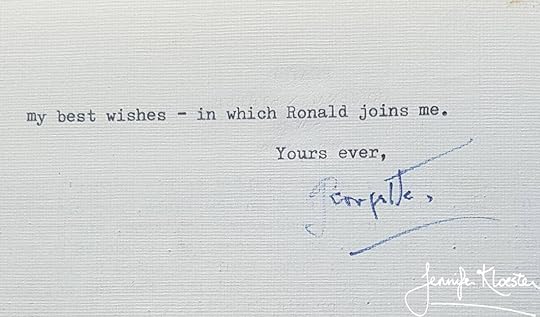
Merry Christmas, happy Yule and a joyful festive season everyone!
I hope you all have a wonderful Christmas and holiday season and that 2021 is a better year for the world. Thank you for coming along with me on this Georgette Heyer journey. I’m looking forward to many more “Friday Heyer” posts in 2021 as well as many more Heyer moments, essays and articles from our new and fabulous International Heyer Society. If you haven’t joined, do take a look, as each week we offer a special post for members and every month there is a new edition of Nonpareil, our fabulous magazine full of wonderful essays and articles about Heyer, her writing and her world.
2021 is a special year for Heyer fans as it marks one hundred years since the publication of The Black Moth. Her first novel was published in September that year and we will be celebrating her achievement with a Heyer convention in Melbourne. We’ll announce the date as soon as Covid circumstances allow us to book the venue and we plan to Zoom the proceedings so that travel restrictions will not prevent anyone from joining us in marking this very special occasion.
HAPPY NEW YEAR ONE AND ALL. STAY SAFE AND WELL AND MAY 2021 BRING MANY GOOD THINGS TO YOU AND YOURS!
Best wishes, Jennifer Kloester
December 18, 2020
So perceptive – the Private World of Georgette Heyer
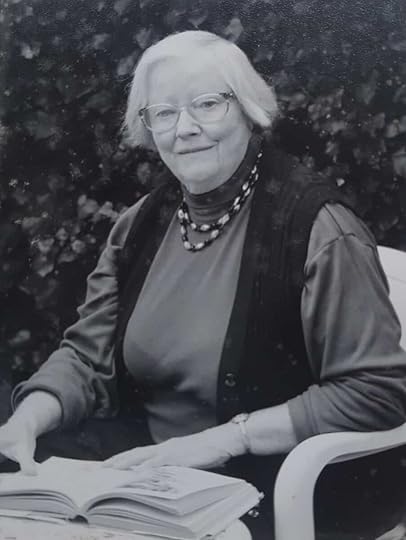 Jane Aiken Hodge had a remarkable mind and was a much-loved author.
Jane Aiken Hodge had a remarkable mind and was a much-loved author. A memorable meeting
In a memorable meeting, I first met Jane Aiken Hodge early in 2002. I had travelled to England for what was to be the first of several marvellous research trips to further my PhD research about Georgette Heyer, her life and writing, and was eager to meet Heyer’s first biographer. Jane’s excellent biography,The Private World of Georgette Heyer, had given me my first insight into one of my favourite authors and I was keen to meet the woman whose book had helped to bring the very private Georgette Heyer into the open. I’d written to Jane asking for an interview and she very kindly invited me to lunch at her home in Lewes in Sussex. I was very nervous but Jane made me very welcome and we spent several hours over lunch and afterwards in her garden discussing all things Heyer, Jane’s extensive research and her own writing career. Jane Aiken Hodge was not only a successful author in her own right but she also had a fascinating literary pedigree: her father was the famous poet, Conrad Aiken, and her sister was the beloved children’s author, Joan Aiken. I had grown up reading Joan Aiken’s novels and The Wolves of Willoughby Chase had been one of my favourite books. A highly intelligent person, Jane was quick-witted and perceptive – qualities which enabled her to bring the unknown Georgette Heyer into the public eye for the very first time. Jane was also incredibly generous and she gave me a gift I shall never forget.
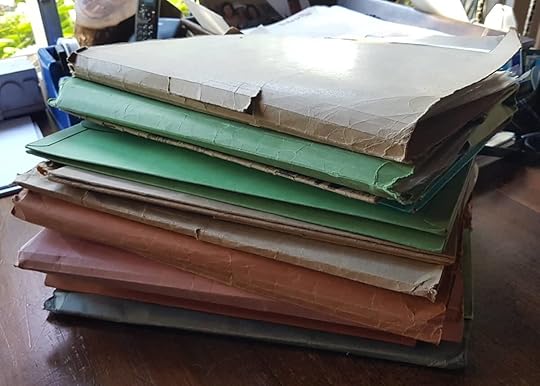 Jane Aiken Hodge’s research files for her 1984 Heyer biography
The Private World of Georgette Heyer
Jane Aiken Hodge’s research files for her 1984 Heyer biography
The Private World of Georgette Heyer
Jane’s research files
When I arrived at her house that day, one of the first things Jane said was: “I’ve asked my housekeeper to bring my research files down from the attic” – she gestured to a pile of coloured manila folders on her dining table. “I thought you’d like to take a look at them” (understatement of the year!). But first we had to have lunch and we talked so eagerly through lunch and afterwards that before I knew it, it was time to leave. She ushered me back into the dining room from the garden and I quickly opened the first folder. There in front of me were original letters written by Georgette Heyer to her agent, Joyce Weiner, many of them typed and some hand-written, but all with her characteristic signature. I couldn’t believe it! Nor could I believe that I had to leave without having scratched the surface of the contents of those twelve folders! It was agony knowing that here was a treasure trove of information and I’d run out of time. I wasn’t sure whether I would have time to return or even if Jane would be willing to have me back for a second visit.
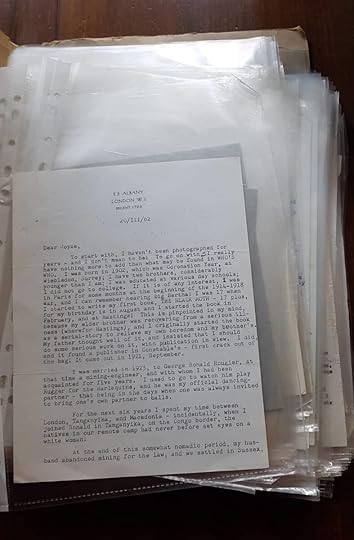 A folder of original letters from Georgette Heyer to her agent, Joyce Weiner.
A folder of original letters from Georgette Heyer to her agent, Joyce Weiner.“Take anything you want”
I’d just opened the second folder when Jane said kindly, “Take anything you want.” Wow! Well, it was a very generous offer, but I was an academic researcher studying for my PhD and I knew that to break up an archive and thereby lose its original context and full import was something of a cardinal sin. I thanked Jane, refused politely and regretfully closed the folder. I was getting ready to depart for the station in order to take the train back to London when Jane suddenly said, “Look, why don’t you take it? Take the lot!” I gasped and had begun to stammer out all the reasons why I couldn’t possibly do such a thing, when Jane darted out of the room, returning a minute later with a Swan Hellenic cabin bag in her hand (I still have that bag). She dumped the bag on the table pushed the folders inside it, zipped it up and shoved it into my arms. I was almost speechless as she escorted me to the front door, and when I managed to stutter a few words of thanks she waved them away, opened the door and saw me on my way. I hugged that bag all the way back to London and if someone had offered me the crown jewels in exchange for those folders I would definitely have said no!
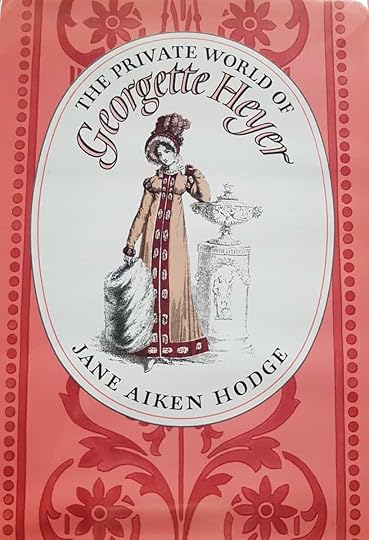 The 1984 Bodley Head first edition of
The Private World of Georgette Heyer
The 1984 Bodley Head first edition of
The Private World of Georgette Heyer
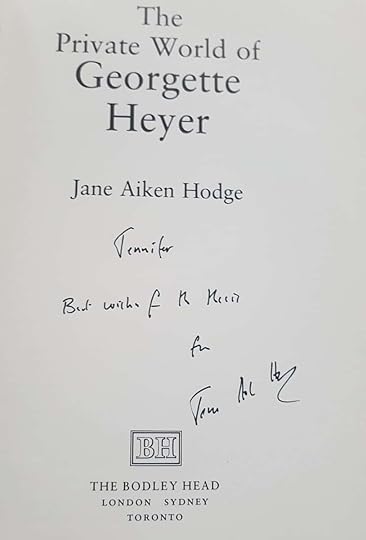 Jane’s kind message to me in the signed edition of
The Private World of Georgette Heyer
Jane’s kind message to me in the signed edition of
The Private World of Georgette Heyer
Informative, entertaining, and remarkably perceptive
I have always been impressed by Jane Aiken Hodge’s biography of Georgette Heyer because, despite the limited primary material available to her at the time, Jane still managed to write an informative, entertaining and remarkably perceptive account of one of the world’s most reclusive bestselling authors. Jane had the family’s support for the biography – Georgette’s son, Richard Rougier, was keen to see his mother’s work formally recognised and he cooperated with Jane, granting her access to his mother’s private papers,her research notebooks and the remnant of her vast research library. Richard also encouraged those who had known Georgette best to speak to Jane – both friends and family – and they did. Jane wrote a wonderfully honest Foreword to her biography in which she questioned whether one should in fact “Try and look behind the curtain of privacy in which she shrouded herself?” but as she began to talk to those who had known Georgette, it appeared that they welcomed a book about their friend; it was Heyer’s letters that settled it for Jane, however, for as she said,
“She may have been a private person socially, almost a recluse, but on paper she was a compulsive communicator.”
Jane Aiken Hodge, The Private World of Georgette Heyer, Pan, 1985, p.10.
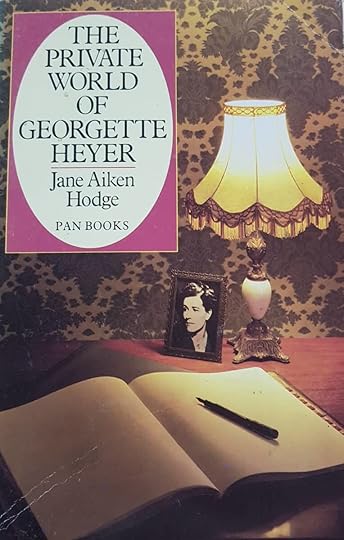 The 1985 second edition of
The Private World of Georgette Heyer
The 1985 second edition of
The Private World of Georgette Heyer
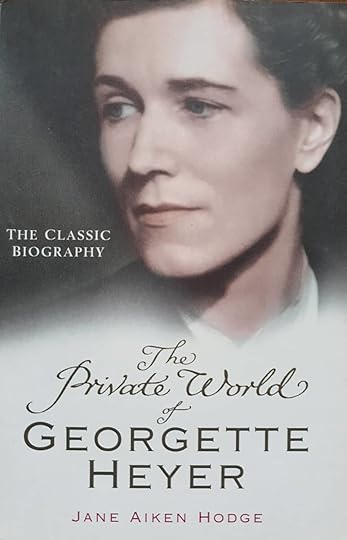 The 2006 Random House Arrow edition of
The Private World of Georgette Heyer
The 2006 Random House Arrow edition of
The Private World of Georgette Heyer
Jane’s achievement
What makes Jane’s achievement so remarkable is that, despite only having Georgette’s letters from 1944 onwards, her biography proved remarkably discerning. Many of the ideas, theories and deductions which Jane postulates in The Private World of Georgette Heyer were later proven to be true and yet Jane only had Georgette’s letters dating from 1943 when Heyer was 41 and already an established author. Twenty years later, several new, untapped archives of her letters would become available (I was extremely fortunate to have access to Heyer’s letters dating from as early as 1921, when Heyer was eighteen and had just received her first pubishing contract) and these additional archives of nearly 800 letters would shed much more light on her early life and writing and would even upend several longstanding family legends. The absence of this vibrant new material did not stop Jane Aiken Hodge from writing an insightful, valuable account of Georgette Heyer’s life and writing, however. I have long been impressed by how many of Jane’s postulations about Georgette’s life, attitudes and actions that, with the evidence that came to light two decades after she wrote The Private World of Georgette Heyer, proved to be entirely correct. Faced with limited material, in order to write her biography, Jane read all of Georgette Heyer’s novels in chronological order, an experience she described as “rewarding” as “Well as delightful”. Heyer once said: “You will find me in my work”. Certainly Jane Aiken Hodge did so and to fine effect.
December 11, 2020
No Wind of Blame – a “Prince” of a novel
As checking at his voyage, and that he means
No more to undertake it, I will work him
To an exploit, now ripe in my device,
Under the which he shall not choose but fall;
And for his death no wind of blame shall breathe,
Hamlet, Act IV, scene 7, 70-75
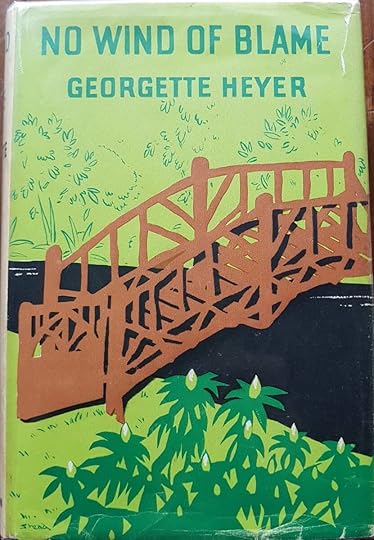 The 1939 Heinemann first edition jacket of
No Wind of Blame
The 1939 Heinemann first edition jacket of
No Wind of Blame
A favourite with many readers of her detective novels, Georgette Heyer’s eighth outing in the mystery genre was No Wind of Blame. A delicious confection of witty dialogue and comic characters, she must have had great fun writing it. She rather enjoyed writing detective novels and in later years, her son, Richard, would explain that she thought of them ‘rather as one would regard tackling a crossword puzzle – an intellectual diversion before the harder tasks of life have to be faced.’ No Wind of Blame certainly shows Georgette in her element, creating a cast of characters who would make her readers laugh. Ermyntrude Carter is a middle-aged matron and former chorus-line dancer who, in the days of her youth and beauty, had married a very wealthy man and turned “respectable”. She lives in a grand house with a large staff and has one daughter from her first marriage. Vicky is one of the stars of the novel. An intelligent young woman and incurably honest, she is a natural actress and each day reveals herself in some new role complete with appropriate clothing. Vicky is by turns “The Sports Girl”, a Russian romantic, a “femme fatale“, “Sonia the Spy”, Arty girl, “Early Victorian”, “River Girl”, “One of the Younger Set”, and in an act of consummate strategy, “martyred murder suspect”. Georgette also took great delight in having a purported Russian prince arrive at “Palings” – Ermyntrude’s mansion – and Prince Varasashvili proves to be very good value, especially when he is called “Prince” and so is the family’s old spaniel! Halfway through the book, Heyer brings her clever detective, Hemingway (now promoted from Sergeant to inspector), onto the scene and there are some very funny scenes between the psychology-loving Inspector and the drama-loving Vicky, each of whom quickly (and accurately) takes the other’s measure.
Miss Georgette Heyer has strong claims to be considered the wittiest of detective story writers
Daily Mail
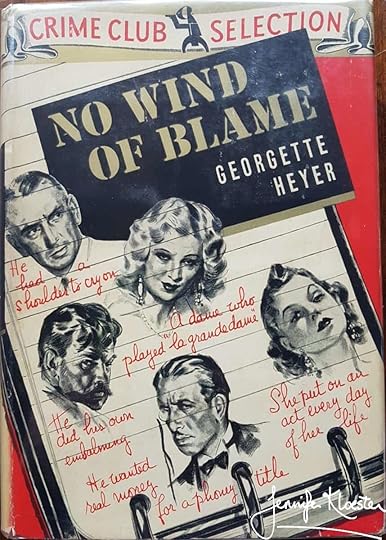 The 1939 Doubleday Doran US Crime Club edition of
No Wind of Blame
with the fabulous ‘Clue” style character illustrations.
The 1939 Doubleday Doran US Crime Club edition of
No Wind of Blame
with the fabulous ‘Clue” style character illustrations.Inspector Hemingway
When Ermyntrude’s husband, the unpleasant, grifting, Wally Carter is murdered, the local police are baffled. While there are enough suspects, each with viable motives, the murder method proves impossible to solve and Inspector Hemingway of Scotland Yard is called to the scene. Wally has proved a poor choice of husband and, despite Ermyntrude’s generosity and tolerance for his many pecadilloes, was a resentful, whining fellow, forever on the take and who, to add to his sins, has made a local girl pregnant. It proves to be the final straw for Ermyntrude, and with the Prince urging divorce so that he might win her hand (along with her large fortune), the brother of the pregnant girl demanding recompense, their vulgar neighbour, Harold White, making free of Ermyntrude’s house and Vicky knowing far too much about various sensitive subjects, Georgette was in her element stage-managing the three-act comedy.
“One of the grandest comedy-situations I’ve handled yet”
No Wind of Blame was Heyer’s fourth book for Hodder and Stoughton, and by now she had taken the measure of the firm’s head, Percy Hodder-Williams. She knew him to be a man of principle, but she had also discovered that his devout Christian beliefs (the Hodder-Williams were Nonconformists) had more than once affected his business decisions and caused him to refuse publication of any book which he did not feel complied with the firm’s policy that their novels should have “nothing in them which would shock or harm any reader from ten to eighty”. It was this stance that prompted Georgette to tell her agent that No Wind of Blame was
“going on well, but I doubt whether it will please Uncle Percy. When I concocted a conventional motive for murder, & hung it on to a guiltless suspect, I did not foresee that this motive was going to get right out of hand, & develop rapidly into one of the grandest comedy-situations I’ve handled yet. But I won’t pretend that it’s quite nice, because it isn’t. I never write smut, nor have I a liking for prurient minds– preferring the broader, Elizabethan style! I can only tell you that some of the sallies have made Ronald shout with laughter – but they have also made him wonder “what-Uncle-Percy-will-say.” One good thing is that Uncle Percy can’t say much, because if he turns it down Frere would snap it up.’
Georgette Heyer to L.P. Moore, letter, 28 January 1939
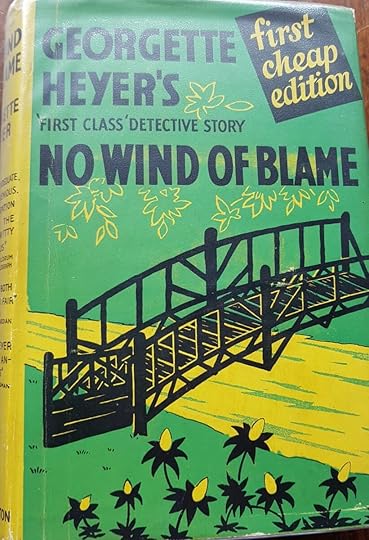 The first “Cheap Edition” November 1939
The first “Cheap Edition” November 1939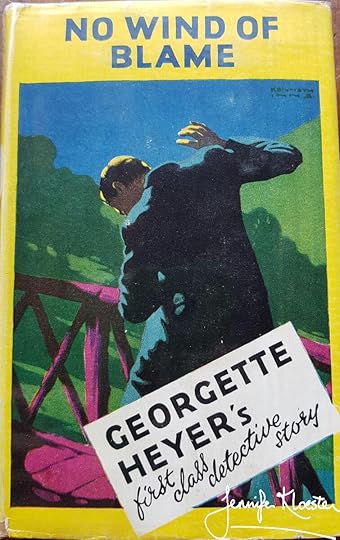 The Yellow Jacket edition 1940
The Yellow Jacket edition 1940A selling novel
However, Hodder & Stoughton knew a selling novel when they read one and in June 1939 they published No Wind of Blame. In the autumn of 1938, Georgette, like many Britons, had been keeping a close eye on the political situation in Europe and the day the British Prime Minister, Neville Chamberlain, signed the Munich Agreement and declared “Peace in Our Time”, she finally felt able to focus on the new novel. She confessed to being “quite played-out” by the events in Europe but assured her agent that she would “soon revive” and would then “bend her mind to the new thriller”. She warned him that it would be a little while longer before Ronald could “bend his mind to the thriller”, however, because his final Bar exams were pending and he would be unable to think of much else until they were done. It was Ronald’s job to work out the “how” of the murder mystery and Georgette’s to work out the who and the why. In the case of No Wind of Blame it seems that Ronald also had a hand in the “Why” of the murder, which proved to be so opaque that Georgette wrote to Moore to explain the thinking behind it:
For your private ear, the motive is highly technical, & the method of murder even more so. So obscure is it that although several vital clues are presented to the reader right at the start, I think it will be an exceptional reader who a) recognizes them as clues, & b) grasps their significance. You can tell H&S that much, if you like.
P.S. ‘I’m trying to work out this sort of reaction in the reader. Assuming “A” to be the murderer, the reader should feel
(1) A is obviously a villain.
(2) A is too obviously a villain.
(3) I hope A does the murder when there is a murder.
(4) I see A cannot have been the murderer.
(5) I am disgusted to find that, although suspicious, A was the last man to have desired Wally’s death.
(6) If A really did do it, why on earth?
(7) If A did it, how on earth?
Georgette Heyer to L.P. Moore, letter, 29 November 1938
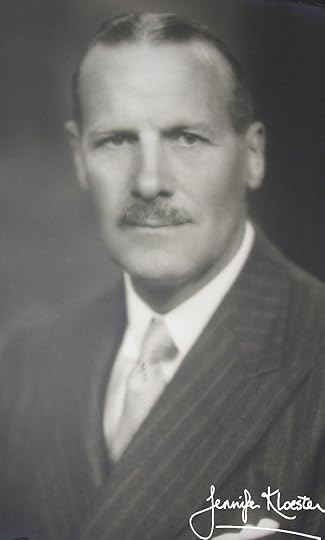 Ronald Rougier around the time he was admitted to the Bar in 1939.
Ronald Rougier around the time he was admitted to the Bar in 1939.Ronald’s murder method
Ronald devised a clever but complicated murder method – so clever that the War Office took an interest in it – but it certainly baffles any reader ignorant of the technical aspects of guns. Georgette had written most of No Wind of Blame and had reached the all-important denoument when everything is explained, only to find that she had no clear idea of just how her murderer had killed his man.
‘I DID know, broadly speaking, how the murder was committed, but I didn’t clutter up my mind with the incomprehensible details. Ronald swears that he came home one evening when I was at work on the final, explanatory chapter and that I said to him: “If you’re not busy, could you tell me just how this murder was committed?”‘
Reading the novel and reaching the final explanation, it’s fun to imagine Ronald explaining it all to Georgette and perhaps taking out one of his guns to demonstrate exactly how the deed was done. They were still living at Blackthorns when she wrote the novel and the house was home to many of the souvenirs and curios from their time in East Africa, among them Ronald’s guns which he had used for shooting big game. His experience with guns is easy to discern in No Wind of Blame and there is definitely something of Ronald in the character of the aptly named Robert Steel. There is also something of Georgette in the novel – or at least a reflection of her feelings about Richard. She was very much of her time in the way she responded to her son and her disinclination to overtly praise him or to express her deep love and affection for him is made clearer in the part of No Wind of Blame where she describes Sir William Dering’s attitude to his only son, Hugh:
‘Whenever anyone asked him questions about Hugh, he naturally disparaged him, and said that he was an idle young hound, and that he didn’t think he was all that clever (though, as a matter of fact, he took a first in Greats, for what that was worth), or particularly good at games (though actually he got his Rugger Blue, and had entered for the Amateur Golf Championship last year; not that that was anything to make a fuss about); but if Sir William had ever been obliged to enter a confessional, and to state his true opinion of his son, he would have said, with the utmost reluctance, that Hugh’s equal for character, brains, physique, athletic prowess, and general virtue did not exist.
Georgette Heyer, No Wind of Blame Heinemann, 1952, p.232.
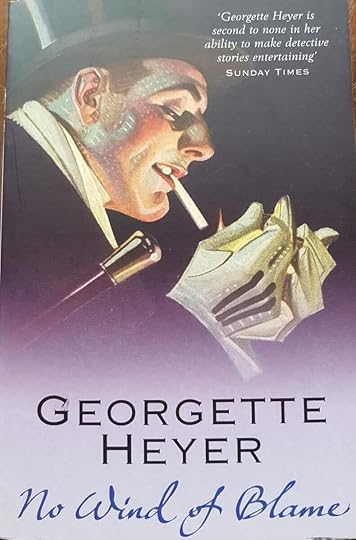
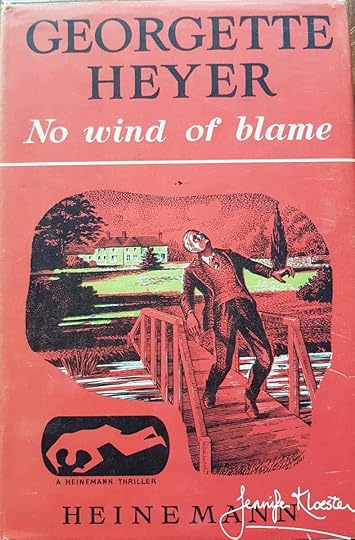
“Equally entertaining and equally light-hearted”
No Wind of Blame would be Georgetrte’s last truly light-hearted modern novel for War was coming and soon she and Ronald would hear the guns across the Channel and know that not so many miles away, young men were being slaughtered on the battlefield. That hideous reality would soon make it hard for Heyer to write humorous modern dialogue and to depict bright young men bantering about murder when they were being killed. But Georgette Heyer’s novels would prove to be a much-needed escape from the horrors of war and No Wind of Blame was judged a delightfully comic novel and one which would stand the test of time.
‘Equally entertaining and equally light-hearted is Miss Georgette Heyer’s No Wind of Blame. The method used to murder a diverting but worthless individual is ingenious–too ingenious for belief; but what does that matter when we are laughing at the good-hearted vulgarity of Mrs Carter, the posing of her daughter, the floundering of the police-inspector, and the exquisite corrrectness of Prince Varasashvili (so awkward to have a prince as a guest when one’s own dog is called Prince)? Miss Heyer has produced a very funny book in which character-drawing and comic situation are well-matched. Murder, however, seems too heavy a stone to throw into the delightful ripples of life at Stilhurst
The Times, 4 July 1939, p.10
December 4, 2020
Royal Escape – a labour of love
 The 1938 Heinemann first edition dustjacket
The 1938 Heinemann first edition dustjacket“On the road to White Ladies”
Georgette began writing her new historical novel in the spring of 1938. It was not an easy time in Britain, for the storm-clouds of war were gathering and rumour and uncertainty were rife. An eager reader of The Times, Georgette kept abreast of the political situation and she and Ronald undoubtedly discussed the government’s approach and, in particular, the Prime Minister Neville Chamberlain’s policy of appeasement. They were both conservative in their politics and in their daily lives, but Georgette was not convinced by Chamberlain’s pronouncement in September 1938 that he had achieved “peace in our time”. Given her awareness of the tensions in Europe it is not surprising that the three historical novels she wrote between 1936 and 1939 were about war and that each were strongly nationalistic and favoured Britain and its monarchy. An Infamous Army had been about the British victory at Waterloo and she now decided to re-tell the story of Charles II’s escape from Cromwell’s England after the Battle of Worcester in 1651. Charles II was the monarch about whom she had originally written in 1922 in her post-Restoration novel, The Great Roxhythe. The new book was to be set nearly twenty years earlier than Roxhythe and this time the king would take centre stage. Once again, Georgette read avidly and set herself the task of visiting every house and inn at which Charles had rested or hidden during his perilous flight to France. In April she ended a hasty letter to Moore with: ‘No time for more. On the road to White-Ladies, & the dawn at hand.’ It was to White-Ladies Priory that Charles II had been guided after the Royalist defeat and where he had been sheltered after the battle.
 The 1939 Doubleday Doran American first edition
The 1939 Doubleday Doran American first editionNo Cromwellian
Georgette was no Cromwellian and throughout her life she held to the belief that the Royal Stuarts were the true kings of England and that the Hanoverians were, if not usurpers, at least intruders. She was extremely annoyed when Queen Elizabeth II named her firstborn son Charles, given that it was a Stuart name, and the Windsors were descended from the German Hanoverian kings. Still, these were trivial matters, and once she began writing the new novel, Georgette quickly became immersed in the sources. She called the book Royal Escape and in her usual meticulous fashion not only visited every inn connected with King Charles’s escape, but also took copious notes from books borrowed from the London Library. Her research notebook shows how she drew the details of the King’s journey from the different primary texts, writing them down in parallel columns and annotating as she went. She worked hard on the novel which took her almost four months to write and produced, if not a riveting tale, at least a worthy one.
 One of Georgette Heyer’s rare bibliographies.
One of Georgette Heyer’s rare bibliographies. A bibliography
Royal Escape is not without its fast-faced, compelling scenes; the characterisation is good and the language feels authentic and this is due to Heyer’s diligence in reading as many of the firsthand sources as she could. Royal Escape is one of the rare Heyer novels that includes a bibliography so it is easy to see from where she drew her period language and the details of her story. It is a detailed story – perhaps too detailed – for Heyer tracks the King’s journey from Worcester to White Ladies, to the Penderel’s, the Royal Oak, Wales and Bristol and all the places in-between as though she were afraid to leave anything out of such an important historical story. She makes a good fist of the material and at times the novel is well-paced and interesting; the King’s reactions to his trials and tribulations are clearly depicted, but there is something lacking in the overall effect. Jane Aiken Hodge in her 1984 biography of Heyer offered a perceptive account of the novel’s challenges:
‘in the main she was inhibited by the very richness of her sources. She puts a ripple of amusement into the King’s voice from time to time, but cannot bring him to life. Partly because of the limitations imposed by the plot, there is a failure of tension in Charles’s relations with the people around him
Jane Aiken Hodge, The Private World of Georgette Heyer, Pan, 1985, p.59
 The 1965 Pan edition
The 1965 Pan edition“Immense fun”
There is no doubt that Heyer enjoyed researching and writing Royal Escape and years later, Sylvia Gamble, the young woman who had been employed to type up An Infamous Army, reported that she and Georgette had had “immense fun” driving around the countryside in pursuit of all the places in which the King had hidden during his escape from Cromwell’s army. By the time she had finished the novel, however, Georgette had begun to have doubts about Royal Escape and in a letter to her agent expressed the hope that it ‘will not be a long, dull book! You never know – perhaps continual travel & escape becomes boring’. Heyer was perceptive but, while some readers agree with her assessment of the novel, the critics of the day were more flattering. When Royal Escape came out in America in February 1939 it was warmly received with enthusiastic reviews in The New York Times, The New Yorker and The Saturday Review, whose critic declared that:
Miss Heyer is adept at giving full-bodied reality to such a story. Casual readers who know her only in another role and remember her only by such detective tales as They Found Him Dead will be prepared for the ease with which she develops her narrative, but they will be amazed at the learning which she displays so dexterously and so generously. She has taken her sources as seriously as would a professor of history, and has weighed all the evidence of those multitudinous tracts that, with the Restoration, celebrated Charles’s miracle.
Charles David Abbott, ‘King Charles on the Run’, The Saturday Review, 4 February 1939, p.7
On 5 October 1938, Georgette accompanied Ronald to London for the Bar exams. They stayed at the Waldorf Hotel and while Ronald attended the Inns of Court, Georgette arranged to have lunch on different days with Joanna Pullein-Thompson, her publisher Alexander Frere and her agent Leonard Moore. It was a welcome break from literary cares for she had been feeling ‘dreadfully depressed’ about Royal Escape. Although she had garnered several good reviews for the book in the British papers, she had not been pleased by what she felt was “a luke-warm review in the Times Lit. Supp. Written by a Cromwellian, I fancy”‘ But British sales for the book exceeded her expectations and in January 1939, Frere showed her ‘some nice-looking figures’. In its first three months Royal Escape had sold nearly 8,500 copies – 1,500 more than An Infamous Army and 3,000 more than Regency Buck – and the figure did not include the Christmas sales. Georgette would write one more book about war, The Spanish Bride but before that she would pen one of her funniest detective novels, No Wind of Blame.
 The 2005 UK Arrow edition
The 2005 UK Arrow edition
November 13, 2020
A Blunt Instrument – a killing comedy
In August 1937 Georgette Heyer completed the manuscript of her Waterloo novel, An Infamous Army. It had been a huge effort requiring intense research and long days of reading and writing and she had loved every minute of it. She had written the manuscript in “meticulous longhand” and then asked her agent to find her a typist who would come and stay at Blackthorns so that she could read her manuscript aloud – “complete with punctuation” – have her typist take it down in shorthand and then type it up ready for the publisher. The typist was Sylvia Gamble, a young north country woman who had declined the opportunity to study at Cambridge and chosen instead to become a literary secretary. Sylvia stayed at Blackthorns for a fortnight and, although she was only twenty-four to Georgette’s thirty-five, they became good friends. Sylvia later described her as having ‘a beautiful brain’ and an ‘ordered intellectual apparatus’ and was in awe of Georgette’s ‘meticulous historical research’ and impressed by how seriously she took her novels. In 1938, Sylvia would accompany Georgette on several of her research trips for her novel of Charles II, Royal Escape, but in late 1937, having dealt with the proofs of An Infamous Army, Georgette first turned her attention to her next detective novel.
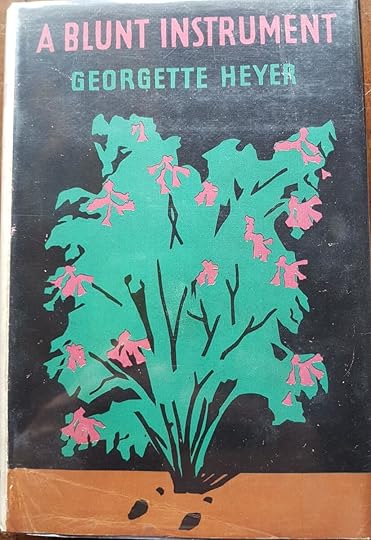 The 1938 Hodder & Stoughton first edition of
A Blunt Instrument
.
The 1938 Hodder & Stoughton first edition of
A Blunt Instrument
.“By far the best, wittiest” detective story”
On publication in May 1938 A Blunt Instrument was described by the famous reviewer, Torquemada, as “by far the best, wittiest and, for want of a better term, truest detective-story that Georgette Heyer has yet written”. It was a glowing compliment and Georgette later confessed that she “almost let it go to my head”. Though increasingly self-deprecating about her writing and sometimes asserting that she did not keep reviews, Georgette certainly read and cared about them. She was appreciative of a good review and complimentary of any reviewer she thought perceptive but she was alsowriting accepting of criticism if she thought the reviewer fair. Contrary to popular belief, Georgette Heyer was often reviewed in the major and minor British papers and regularly in the papers in America and Australia. By the late 1930s she had already developed a loyal following for both her historical and her detective fiction.
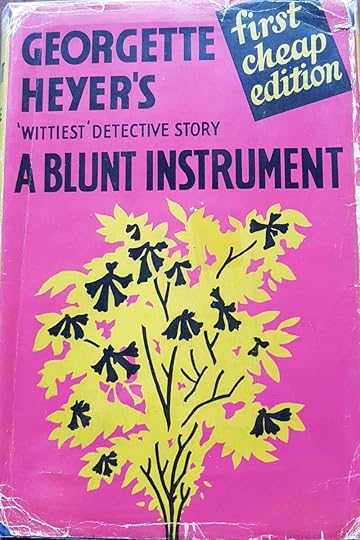 The 1940 H&S “Cheap edition”
The 1940 H&S “Cheap edition”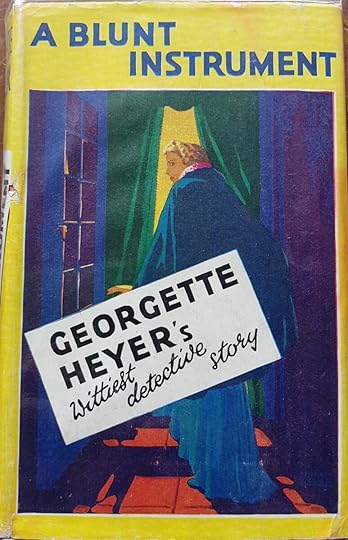 The 1940 H&S Yellow Jacket editionThe covers of the Hodder & Stoughton ‘cheap editions’ of
A Blunt Instrument
The 1940 H&S Yellow Jacket editionThe covers of the Hodder & Stoughton ‘cheap editions’ of
A Blunt Instrument
Ronald “largely responsible for the plot”
Though she had finished writing An Infamous Army in August, Georgette was unable to immediately begin writing A Blunt Instrument because Ronald was busy studying for the next round of Bar exams in October. According to Georgette, it was Ronald who was ‘largely responsible for the plot’ and, athough she had the “general outline” of the novel in her head, she couldn’t send her agent a synopsis until her husband was free to discuss the murder with her. It must have been an interesting and at times challenging collaboration because Ronald and Georgette were so very different in both brain and temperament. While there is no doubt that Georgette Heyer was perfectly able to contrive a murder plot for herself and to execute the detective elements without assistance – after all, Ronald had had no hand inThe Talisman Ring or Death in the Stocks and they were both clever and successful books – he had been a keen supporter of her writing since their marriage in 1925. He obviously took delight in “hunting up” unusual details, finding elusive bits of research, making suggestions and he always read her manuscripts. It was Ronad’s response to the drafts of whatever she was working on that told Georgette whether she was on the right track or not. The challenge, however, in having Ronald devise the murder method for her detective novels lay in his having no idea about character or relationships. According to their son Richard, Ronald would say something like: “A does this and then B kills him and then A does that” only to have Georgette say “Oh no, A would never behave like that” . In her 1984 biography, Jane Aiken Hodge asserted that:
‘Harnessed to his plots, however technically sound, her genius was inhibited, and it showed. There is a failure of homogeneity in these books, with character too visibly giving way to plot.’
Jane Aiken Hodge, The Private World of Georgette Heyer, p.50.
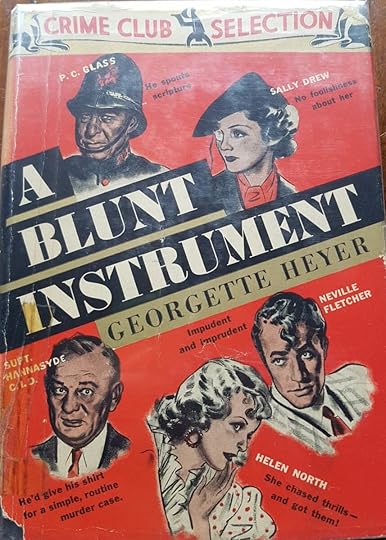 The first US edition published by Doubleday Doran for their Crime Club series
The first US edition published by Doubleday Doran for their Crime Club series“Delicately pointed wit”
“Georgette Heyer, in A Blunt Instrument, gives a brilliant display of the most delicately pointed wit: she can be guaranteed to keep you in fits of laughter…”
Nicholas Blake, “Romance of Detection”, The Spectator, 17 June 1938
Ronald finished his Bar exams and in mid-January 1938, Georgette began writing her seventh detective novel. She originally called it “Blue Murder” and easily produced the first 10,000 words, telling Norah Perriam that ‘some of it [is] quite funny. You’ll be glad to hear that the corpse is discovered on the first page, & there is no assembly of characters to be sorted out.’ On finding that “Blue Murder” had already been used, Georgette changed the title to A Blunt Instrument – a remarkably apt title though the blunt instrument remains genuinely elusive for much of the novel. Another three chapters quickly followed the first 10,000 words and by 10 February she had finished the book. She sent the manuscript off to her agent and, in a style that was becoming increasingly self-deprecating, told Norah Perriam that she was sick of the book.
‘That’s all – DO your best for me! I make it about 72,000, but better get the typist’s estimate. Let me have it back to correct as soon as you can! I’m sick of it
Georgette Heyer to Norah Perriam, letter, 10 February 1938
Incredible
It seems incredible to me (who takes a year to write a novel and took four (!) years to write Jane Austen’s Ghost) that Heyer was able to write so many of her novels in a matter of weeks. What a mind she must have had and what a memory! And her detective novels are so often funny. And in A Blunt Instrument her humour is no less evident for the speed with which she wrote it. Reviewers were quick to acknowledge that Georgette Heyer was a crime writer whose sense of humour set her novels apart from most detective fiction. A Blunt Instrument is a very funny book in places with some brilliant characterisation and dialogue and for many readers the murder is a genuine mystery. James P. Devlin described the novel as her “masterpiece” and there is no doubt that her creation of Malachi Glass, the mournful, bible-quoting policeman, who turns up at all the wrong moments, is masterful. His encounters with Sergeant Hemingway are a delight and the contrast between PC Glass’s insistence on quoting reproving Old Testament scriptures and Hemingway’s fascination with modern psychology is great fun.
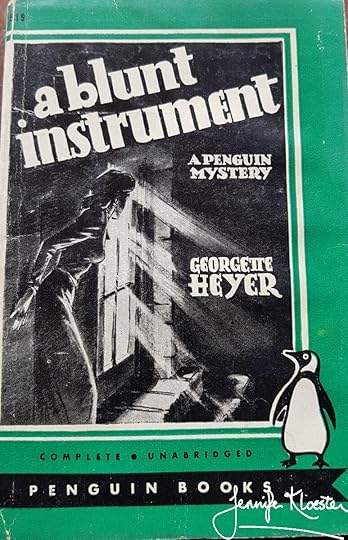 First published in April 1943 in the Penguin edition
First published in April 1943 in the Penguin edition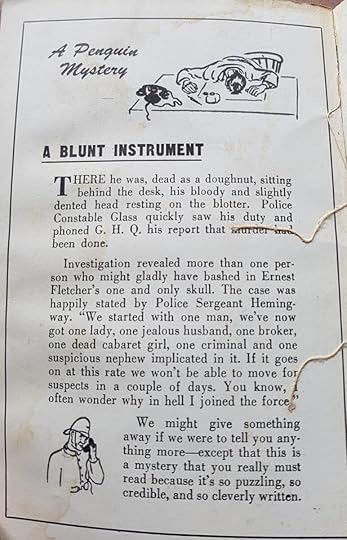 It had already been reprinted twice by March 1944The American Penguin edition of
A Blunt Instrument
.
It had already been reprinted twice by March 1944The American Penguin edition of
A Blunt Instrument
.“Spirited dialogue”
“The pleasure of reading her spirited dialogue and meeting her enterprising characters is not affected by an early guess at the solution.”
Eric Partridge, “Deteection”, The New Stateman and Nation, 25 June 1938.
My favourite character in A Blunt Instrument. is Neville Fletcher, nephew of the murdered man. Neville is one of those delightful characters who would perform as well in a Wodehouse or Sayers’ novel. He is deceptively vague, unintentionally charming, an adventurer, and a suspect in his uncle’s murder. While not loving everything about A Blunt Instrument., I do love Neville, and with her usual expertise, Georgette gives him some very funny as well as very perceptive lines:
“As well as one person may know another, did you know your uncle?”
“No. Interest being the natural forerunner to understanding.”
“You’d none in him?”
“Nor anyone, ‘cept objectively. An’ I’m not sure of that either. Do you like people?”
“Don’t you?”
Neville spread his hands out, slightly hunching his thin shoulders. “Oh, some—a little—at a distance.”
Superintendent Hannayside speaking to Neville Fletcher in A Blunt Instrument, H&S, 1938, p.57.
Perceptive
This delightful comic exchange is both very funny and perceptive. I have also wondered if it offers readers a moment where Georgette Heyer is revealing a little more of herself and giving us a tiny insight into her fierce proclivity for privacy. She did not always deal well with people. Nor did she suffer fools gladly. She was also intensely shy and, despite having a formidable presence, underneath she often struggled in company, once telling her aunt that
“I am a total loss at social functions, being ready to run a mile (almost) rather than go to a party, especially a literary one.”
Georgette Heyer to Alice Bowden (nee Heyer), letter, 20 April 1940.
Whether it reveals something of the deeply personal Georgette Heyer or not, A Blunt Instrument, is an easy read with a clever murder mystery and another of her satisfying Hannayside and Hemingway detective stories. Years after writing it, even Georgette remembered good things about the novel:
‘”Torquemada”, who used to review the [’til] fiction for the Observer, went all out for A Blunt Instrument, and headed a five-column patch in the paper, in fat, black Caps, “The Heyer Direction”, putting me at the top of his list. I never preserve reviews, but I do remember that this one stated: “This is the best, and for want of a better adjective – the truest of Miss Heyer’s detective novels.” I almost let it go to my head!’
Georgette Heyer to Louisa Callender, letter, Heinemann Archive, 27 January 1954.
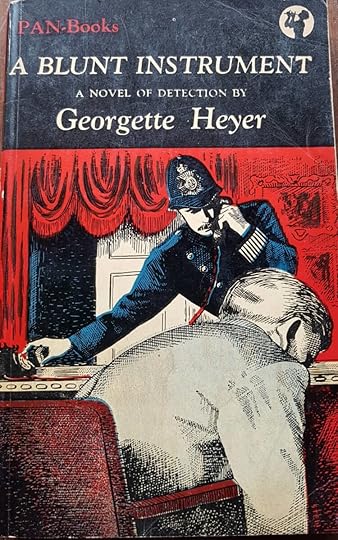 The 1949 Pan edition
The 1949 Pan edition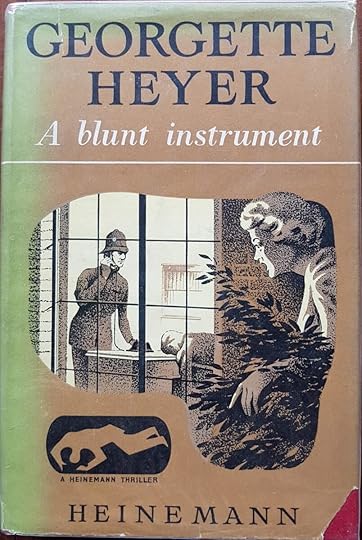 Number 5 in the 1954 Heinemann Numbered Series edition
Number 5 in the 1954 Heinemann Numbered Series edition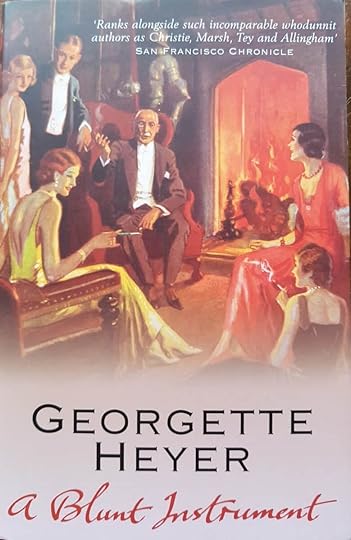 he 2006 Arrow edition
he 2006 Arrow edition
November 6, 2020
An Infamous Army – a triumph
 The Heinemann 1937 first edition of
An Infamous Army
The Heinemann 1937 first edition of
An Infamous Army
Her most ambitious
In mid-November 1936, Georgette Heyer was writing the final chapters of her murder mystery, They Found Him Dead . She finished it by the end of the month and two months later, in January 1937, she began researching a new historical novel. For over four months, Heyer read every book about the Napoleonic Wars and the Battle of Waterloo that she could lay her hands on (nowhere near as many as there are available nowadays). She was excited by the new book which would be her most ambitious and, for many readers, her greatest achievement. She would eventually call the novel An Infamous Army and on completing it sent a plot summary to a new contact at Heinemann: Alexander Frere-Reeves.
There are 26 chapters, of which the final 10 deal with the actual campaign. This is, I think, the right proportion, & comes to a little over a third of the entire book. The story opens on the 4th April 1815, in Brussels. Wellington arrived from Vienna very late that night, & my hero comes with him. This, as you know, is Colonel Audley – who appeared in Regency Buck. His sister-in-law – Judith (heroine of Regency Buck) has found a demure bride for him. Unfortunately, he falls instantly in love with Barbara Childe, Devil’s Cub’s granddaughter – a red-haired, dashing & unprincipled widow of 25. She is very fast, & rather fun. She & the Colonel become engaged, but it is soon seen that there are rocks ahead. This early part is freely interspersed with Wellington’s doings. Don’t let Heinemann be afraid! The Wellington chapters are my best, & most amusing!
Georgette Heyer to Norah Perriam, letter, 23 August 1937
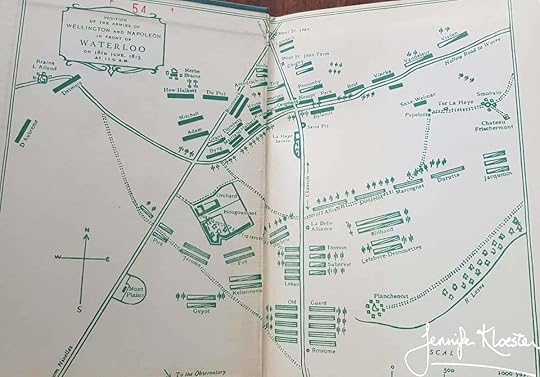 Georgette produce several hand-drawn maps of the Battle of Waterloo. Heinemann used this map for the endpapers of the novel.
Georgette produce several hand-drawn maps of the Battle of Waterloo. Heinemann used this map for the endpapers of the novel.Utterly absorbed
As the projected book took shape in her mind, she became absorbed by the psychology of her characters and the ways in which their various roles in the battle might heighten the drama of her fictional plot. Her hero, Charles Audley, had played a minor role in Regency Buck but she now cast him as a Colonel in the 10th Hussars and subsequently attached to the Duke of Wellington’s staff. When the book opens, Charles’s brother, the Earl of Worth, Judith Taverner (now Lady Worth), her brother Peregrine and his wife, Harriet, are all staying at Worth’s house in Brussels and Georgette took great delight in having several real historical figures, including the diarist, Thomas Creevey, Georgiana Lennox and young Lord Hay, pay them a morning visit. Georgette brilliantly recreates Brussels on the eve of battle with everyone eager for news of Wellington and wondering what will happen in the coming days. Her idea was to ‘lay the situation before the reader, & convey the feeling of alarm & uneasiness before Wellington’s arrival from Vienna’ and Heyer achieves this with all her usual verve and flair.
 The stunning jacket of the 1938 US Doubleday Doran first edition of
An Infamous Army
. The hard cover of the book had the same image embossed on its front.
The stunning jacket of the 1938 US Doubleday Doran first edition of
An Infamous Army
. The hard cover of the book had the same image embossed on its front.“Only the triangle of one girl and 2 men”
Heyer told her agent that ‘There’s not a speck of adventure (in the style of the Talisman Ring)’ but that she was sure she could carry the story off with ‘only the triangle of one girl and 2 men, & the crashing climax of Waterloo’. As she would tell Frere-Reeves a few months later, the heroine, Lady Barbara Childe, was the granddaughter of Devil’s Cub, also known as Dominic Alastair, son of the Duke of Avon in These Old Shades ,and the Marquis of Vidal in her 1931 novel, Devil’s Cub. Vidal is now Duke of Avon and ‘Bab’ is a true Alastair having inherited her great-grandmother Léonie’s flaming red hair, extraordinary beauty and her temper. Many readers have noted the impossible chronology of the Alastair family tree as Georgette depicted it and she later acknowledged ‘that Dominic couldn’t have had grand-children of mature age in 1815′. Georgette had included the Alastair descendants because she felt that the characters’ popularity was such that her readers would forgive a little poetic licence. She never intended An Infamous Army to be a true sequel to Devil’s Cub and her son, Sir Richard Rougier, later explained that his mother simply gave Mary and Dominic Alastair parts in the novel ‘as a sort of friendly wave to previous readers’.

 The elegant spines of the UK and US first editions of
An Infamous Army
The elegant spines of the UK and US first editions of
An Infamous Army
Charles Audley
The two men in the ‘triangle’ were Charles Audley and a Belgian, the Comte de Lavisse, a fictional member of Bylandt’s brigade which retreated from the Battle of Waterloo early in on the action. Georgette described his role as: ‘A nice, though flamboyant young man, but you see the psychological point, don’t you? No romantic girl would look at a defeated man when the other behaved with successful gallantry, & been borne off the field desperately wounded.’ The ‘other man’ was to be Colonel Charles Audley, who, as Georgette explained:
went to the Dss of Richmond’s ball in all the splendour of his Hussar uniform – that is how the girl saw him last on the 15th June. Like so many others, he had no time to change before riding to Quatre Bras on the 16th. He went in full ball-dress, & was sent back on the 17th June, with despatches for the English Ambassador at Brussels, & found time to go to his quarters (the house his brother Worth rented) to change into staff clothes. So then the girl saw him again, with all his splendid ball dress soaked with rain, plastered with mud – oh, you do get it, don’t you? And I think he isn’t interested in her, tho’ she is all melting. He wouldn’t be. He is dog-tired, knows there’s going to be the hell of a battle next day, & seems scarcely aware of her. Just tells Worth disjointed details of the action at Quatre Bras, & the rear-guard fighting at Genappes.
Georgette Heyer to Norah Perriam, letter, 4 MArch 1937.
It is not often that we gain a direct insight into what was going on in Georgette Heyer’s mind while she was writing her novels but here is a moment which reveals not only the scene but also the psychology behind it. Heyer is a romantic and her heartfelt plea to her agent’s assistant “oh, you do get it, don’t you?” conveys so much of her feelings both for and about her characters. She is so good at depicting human emotion and getting the best out of an encounter between her hero and heroine and it’s obvious that she is really seeing the scene with all of its intense drama and pathos as she writes it.
 The 1944 Heinemann Pocket Edition
The 1944 Heinemann Pocket Edition Georgette Heyer in good company in the 1944 Pocket Editions
Georgette Heyer in good company in the 1944 Pocket EditionsReported anecdotally
For many years it has been reported anecdotally that An Infamous Army has long been recommended to students at Sandhurst for its account of the Battle of Waterloo. Heyer’s son confirmed this but, eager to discover more concrete evidence, I wrote to Sir John Keegan the eminent military historian, teacher at Sandhurst from 1960-1986, and the Defence Editor of he Daily Telegraph. to ask him if the story were true. Sir John has written many books about the history of warfare (including about Waterloo in his The Face of Battle and he confirmed the story. I also contacted Major-General Jeremy Rougier who had attended Sandhurst as an officer cadet, before becoming an Instructor and company commander. Major-General Rougier went on to become Director of Army Training and the Engineer-in-Chief of the British Army. It is worth noting he is Ronald’s nephew though this in no way affected his experiences at Sandhurst where An Infamous Army was indeed recommended reading for its vivid account (from the British point of view) of the Battle of Waterloo. In 2002 Major-General Rougier’s corroborative letter to me also included a delightful story:
I can illustrate the international respect that her book attracted. In 1964 I was a military assistant to a member of the Army Board (the top management of the Army) and he was paying an official visit to Belgium. We had a free afternoon; what should we do? “Why not ask the Professor of Military Studies at the Belgium Military Academy to give us a conducted tour of Waterloo?” I said, and so he did. It was fascinating; he knew the position of every regiment at any time on both sides. “At about 3pm Napoleon was standing here – no, here” he would say, moving 10 foot to record the precise spot. At the end I presented him with a copy of Georgette’s book and explained our connection. He was as near speechlessness as a professor of military history can be. “This” he said, holding up the book, “is the nearest to reality that one will ever come without having been there.”
Major-General Rougier to Jennifer Kloester, letter, 11.11.2002
 The 1966 H&S Library of Great Historical Novels edition.
The 1966 H&S Library of Great Historical Novels edition.“Perfect reading”
In 1966 Hodder & Stoughton gained permission to republish An Infamous Army as part of their “Library of Great Historical Novels” series. The beloved historical novelist, Rosemary Sutcliff chose the first four titles and An Infamous Army was her first pick. She wrote a long Introduction to the novel which began with high praise for Georgette Heyer:
‘For me, the Regency Novels of Miss Georgette Heyer have always been perfect reading; and I think that this–apart from their more obvious delights–is because of their good manners…The writing itself–the actual choice and arrangement of words–is meticulous; Miss Heyer is incapable of a clumsy or slipshod phrase, and the likeness to Jane Austen which has developed in her work through the years is certainly not mere pastiche, but comes of a like habit of mind, and a like attitude to written English–a beautifully polished but never glossy English.
Rosemary Sutcliff, Introduction, An Infamous Army, Hodder & Stoughton, 1966.
High praise indeed, but not in the last undeserved, for An Infamous Army is a book to be proud of and one which has brought many readers (including my PhD supervisor) to appreciate Georgette Heyer’s remarkable talent. Her tale of Waterloo, entwined as it is with a rocky romance and tested relationships, real people in her fiction and fictional people who seem real, is stirring and memorable. It also laid a firm foundation for the Regency novels to come. Nor was she quite done with the Napoleonic Wars. Her reading had unexpectedly convinced her of Wellington’s acumen and achievements and two years later she would return to him in The Spanish Bride. As she later said of the Iron Duke: ‘I came to curse & stayed to praise.’ An Infamous Army is a remarkable achievement and in years to come it would be the novel of which Georgette Heyer would be most proud.
 1961 Pan Giant edition
1961 Pan Giant edition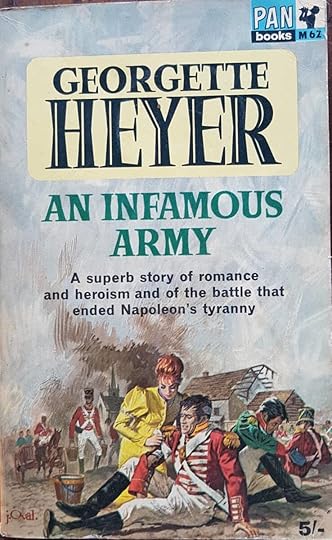 1965 Pan editionIt is unlikely that Georgette Heyer would have approved of these covers depicting Lady Barbara in elgant costume on the battlefield!
1965 Pan editionIt is unlikely that Georgette Heyer would have approved of these covers depicting Lady Barbara in elgant costume on the battlefield!
October 30, 2020
They Found Him Dead
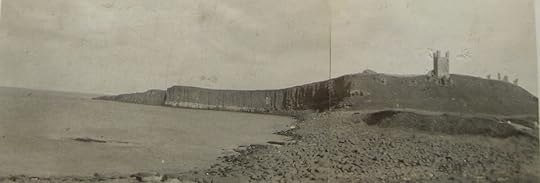 Georgette’s photo of the beach At Bamburgh with the castle in the distance.
Georgette’s photo of the beach At Bamburgh with the castle in the distance.Rest & Recreation
Having delivered The Talisman Ring manuscript in good time to her agent, in mid-July 1936, Georgette once again took her family to Bamburgh for two week’s of rest and recreation. This time she had decided not to stay in an hotel, but had instead booked a house at Number 3 The Wynding, just a short walk from the beach. This Edwardian terrace house must have suited her for she wrote happily from there to Norah Perriam to say that:
“The brain is lying wonderfully fallow! I did bring my typewriter, but haven’t used it, & don’t expect to. I spend my time sitting on the sands, or visiting Places of Interest.
Georgette Heyer to Norah Perriam, letter, 17 July 1936
The weather was lovely and photos show Georgette paddling in the shallows of the bay while Ronald and RIchard enjoy shrimping.
 Paddling in the shallows at Bamburgh
Paddling in the shallows at BamburghA new detective novel
After a few days of sun and sand, Georgette was beginning to think about her next book. She knew it was to be a new detecive novel but that was all and she still had a mind to write some more short stories. After a week at Bamburgh she reported to “feeling much more like myself” and had “collected one or two ideas for short stories” which she planned to write on her return to Sussex. She was home again in August and pleased to find that her Hodder sales for Behold, Here’s Poison were good. Her agent suggested that she might consider taking her historical fiction from Heinemann and letting Hodder & Stoughton have those novels as well as her detective fiction but Georgette wrote back to say:
“I don’t really fancy them instead of Heinemann, but I think an eye might be kept on Heinemann for all that.”
Georgette Heyer to Norah Perriam, letter, 26 August 1936.
She had begun her new detective novel and decided to call it, They Found Him Dead. It was another Shakespearean quote, this time from Act V of King John. Heyer had been raised on Shakespeare and knew many of his plays by heart. The plays, their plots and characters, would inspire many of her novels and much of the vivid characterisation and ironic humour in her books derives from her reading of Shakespeare, Sheridan, Jane Austen and Charles Dickens.
 The 1937 Heinemann first edition of They Found Him Dead.
The 1937 Heinemann first edition of They Found Him Dead.“Mystification and fear”
They Found Him Dead would be her third detective story to feature Superintendent Hannayside and Sergeant Hemingway and would have a large and electic cast of characters. Georgette often drew inspiration for her characters from real life and They Found Him Dead was to be no exception. In addition to her two police detectives, there would be fifteen other people in the book (“exclusive of servants”) and “a general atmosphere of Mystification & Fear”. She thought it would be a good choice for a serial in Woman’s Journal or possibly some other Associated Press magazine but was to be disappointed. Perhaps Georgette’s anger over the unexpected cancellation of Behold, Here’s Poison as a for serial had put the editor, Dorothy Sutherland, offside, but it was to be ten years before she was again serialised in Woman’s Journal. Miss Sutherland had explained that the cancellation had been due to the Abdication of King Edward VIII, but one cannot help wondering why the editor did not pick up more of Georgette’s historical novels after the success of The Talisman Ring. That was for the future, however, and for now Georgette was enthusiastic about the new murder mystery and enjoying herself writing several new kinds of characters.
 The delightful American cover of the1937 Doubleday Doran Crime Club edition of
They Found Him Dead
which included an amusing dramatis personae.
The delightful American cover of the1937 Doubleday Doran Crime Club edition of
They Found Him Dead
which included an amusing dramatis personae.Rosemary Kane
Rosemary Kane is the vain and self-absorbed wife of Clement Kane whose Uncle SIlas is pushed off a cliff. Rosemary is superbly portrayed and has some of the best lines in the novel. She’s a stormy beauty with a personality to match and she has her eye on the handsome Trevor Dermott whom she thinks might make her a better husband than her current spouse, the uninspiring, desiccated, Clement. Rosemary wishes for a more exciting, exotic life and one with a lot more money in it. She plays the victim brilliantly and loves being the centre of attention. Though she and Georgette were not really alike, there is one scene, however, where Rosemary speaks words that might easily have come from Heyer herself:
“You see, I know myself so frightfully well– I think that’s my Russian blood coming out…My grandfather was a Russian… I know I’m selfish, capricious, extravagant and fatally discontented…I wasn’t born to this humdrum life in a one-eyed town, surrounded by in-laws, with never enough money, and the parlour-maid always giving notice, and all that sort of ghastly sordidness…I’m the sort of person who has to have money…you can say what you like, but money does ease things.
This satirical swipe at her own imperfections is very funny, but Heyer also made a point of writing several of her acquaintances into the novel. One of these was a woman she’d met at Bamburgh but she also included “Striking portraits” of her brother-in-law, Leslie, his wife, Tam, and their two young sons. In They Found Him Dead this is the Pemble family (although in the novel the Pembles have a son and a daughter) and Betty Pemble is one of those adoring mothers, always fussing over her children and believing them to be far above the average while Clive Pemble is a decent, taciturn man who sees no fault in his brood. Georgette described them as the “light relief” along with her hero’s mother, Norma Harte who is a “middle-aged Female Explorer (“out in the Congo one gets used to facing danger”), and her son, Timothy, who is a fifteen-year-old “schoolboy with a predilection for American gangster films.” Georgette had a knack for creating convincing characters and young Timothy Harte was no exception. He would prove a great hit with readers and Heyer would bring him back as an adult in her 1951 murder mystery, Duplicate Death. Timothy’s mother, Norma, is one of Heyer’s plain-speaking women and very good value, although one of her forthright statements caused Georgette to receive a written protest from a reader.
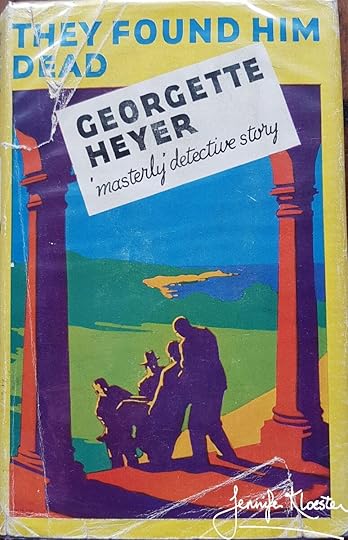 The 1940 Hodder & stoughton “Yellow Jacket” edition of
They Found Him Dead
The 1940 Hodder & stoughton “Yellow Jacket” edition of
They Found Him Dead
The letter to Georgette was from a young woman working in a tobacconist’s shop. She had read They Found Him Dead and been deeply offended by Norma Kane’s frank reaction to her elder son’s Jim’s the announcement of his engagement to Patricia Allison, old Emily Kane’s companion-secretary:
“Jim tells me you are going to be married. I should think you’ll suit one another very well. It’s always been my dread that he might marry something out of a tobacconist’s shop so you can imagine what a relief it is to me to know he’s had the sense to choose a really nice girl. Not that I’m a snob, but there are limits, and young men are such fools.”
They Found Him Dead
The real-life tobacconist’s assistant had sent Georgette a strongly-worded letter of protest in which she demanded an apology, explained that she was removing her from her library list and declaring that, though she worked in a shop, she was “as good as the highest lady in the land”. On the surface, Georgette was untroubled by the complaint for, as she explained to Norah Perriam, “I don’t write for that kind of person, after all” and that she would “regard it as a major tragedy if my son were to marry a tobacconist’s assistant”. To our modern sensibilities this seems (and is) harsh but Georgette had been raised by Victorian parents in a highly structured society that firmly believed in a social hierarchy. In her world everyone had their place, including Georgette. Shored up by her belief in a class system that put tobacconists’ assistants considerably lower down the social scale than herself, her reaction to her correspondent’s complaint was not sympathetic, but it is interesting to note that she never repeated the offence in any of her future books.
 In 1952 Heinemann republished Heyer’s detective fiction in a numbered series.
They Found Him Dead
was Number 1.
In 1952 Heinemann republished Heyer’s detective fiction in a numbered series.
They Found Him Dead
was Number 1.
October 23, 2020
The Talisman Ring – part two
 The rare cover art for The Talisman Ring
The rare cover art for The Talisman Ring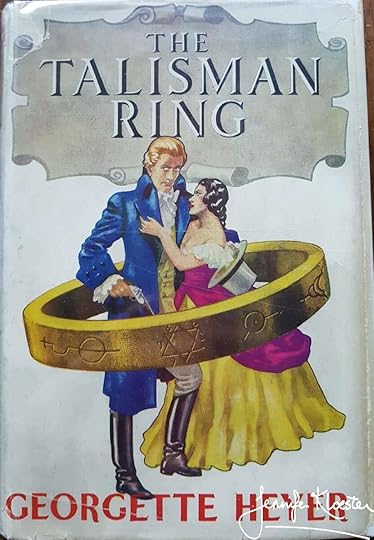 The first edition jacket Heinemann 1936On the left is the rare artwork for
The Talisman Ring
shows the partially-completed watercolour for the 1936 Heinemann first edition shown on the right.
The first edition jacket Heinemann 1936On the left is the rare artwork for
The Talisman Ring
shows the partially-completed watercolour for the 1936 Heinemann first edition shown on the right.Domestic challenges
Despite various domestic challenges, including her “little boy’s illness” and Ronald selling the sports store and preparing to begin his legal training, Georgette Heyer wrote The Talisman Ring in less than three months. On 2nd April she had roughed out the plot and early in May had delivered the first instalment to Woman’s Journal who were to begin publishing her novel in serial form in August. Although the second instalment was delayed due to Richard’s illness, on the 18th May, Georgette wrote to assure Miss Perriam that the second instalment of four chapters would be sent to the editor that week. In a rare moment of self-praise she even went so far to say:
“I hope she will like the four chapters I’m writing now: I think they’re quite good fun myself.”
Georgette Heyer to Norah Perriam, letter, 18 May 1936.
Five days later Georgette delivered the second instalment and a few weeks after that Woman’s Journal received the remaining chapters of The Talisman Ring in plenty of time for the first instalment to appear in the August 1936 edition of the magazine. It was a perfect novel for serialisation with a clever plot, plenty of sparkling dialogue, a bit of cross-dressing, and a cast of highly entertaining characters. Georgette was becoming well-known for her ready wit and ironic sense of humour and this latest novel provided the perfect foundation for her talent. She gave the book two sets of lovers: the melodramatic Eustacie and her daring cousin Ludovic; and the humorously intelligent Miss Thane and the ever-practical, always rational, Sir Tristram Shield. The two couples are polar opposites and Georgette obviously derived enormous enjoyment in creating “farcical” scenes and amusing conversations for these four very different characters. The Talisman Ring proved a great success in Woman’s Journal and the illustration for the first instalment had a marvellous drawing of Sylvester, Baron Lavenham, on his deathbed with his granddaughter, Eustacie, and her serious cousin Tristram, at his side.
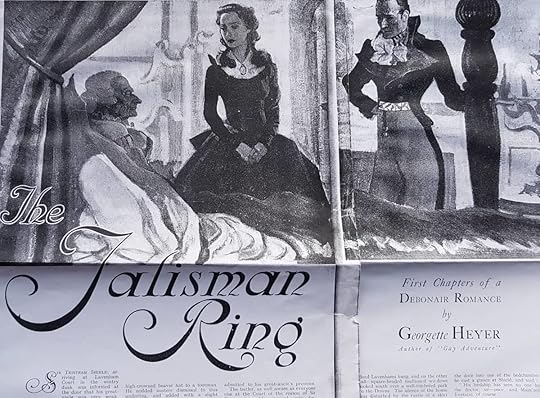 Episode One of The Talisman Ring in Woman’s Journal
Episode One of The Talisman Ring in Woman’s Journal“A hearty laugh”
It was Woman’s Journal’s second instalment of The Talisman Ring that gave Georgette “a hearty laugh”. Perhaps because the illustrator, Clark Fay, had not been properly briefed, or perhaps because he had not read the excerpts and understood that the novel was set in 1793, but his choice of costume was entitely wrong! Clark Fay illustrated the September instalment with a picture of two young ladies attending the wounded hero, Ludovic Lavenham, while wearing ball-gowns! Georgette was astonished by the picture and wrote in some amusement to her agent to say:
“it gave me a hearty laugh. Two ladies in full Victorian ball-dress in the middle of a winter’s morning & staying in a country inn!’ “
Miss Sutherland approves – Georgette does not
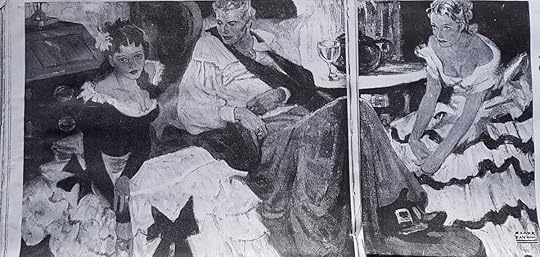 The second instalment of The Talisman Ring in Woman’s Journal, September 1936, illustrated by Clark Fay.
The second instalment of The Talisman Ring in Woman’s Journal, September 1936, illustrated by Clark Fay.The magazine’s editor, Miss Sutherland, did not seem to mind the anachronism but was delighted by the story’s reception. Georgette, however, cared a great deal about historical accuracy and the incident did not improve her already unfavourable opinion of Dorothy Sutherland. Although she would have preferred a more accurate picture to illustrate her story, it was a feather in her cap to have Clark Fay illustrate her work. He was a sough- after early twentieth-century ullustrator who had studied under N.C. Wyeth and Harvey Dunn before going on to produce illustrations for The Saturday Evening Post and Delineator. His most famous work was the Legend of Woksis which depicted the Algonquian chief Woksis, who is credited in mythology with the discovery of maple syrup (it’s amazing where research into Georgette Heyer will take you!). Although his drawings of Sarah and Eustacie are inaccurate in terms of costume, I still love The Talisman Ring illustrations in Woman’s Journal.
Ronald is admitted to the Bar
On 19 June 1936, Georgette and her husband Ronald celebrated his admission to the Inner Temple and the beginning of his training to become a barrister. While it was an important step in Ronald’s career and one of which Georgette seems to have thoroughly approved, it also meant increased financial stress as she was now the sole breadwinner for the family. Life in country Sussex may have been cheaper than life in London, but running a house the size of Blackthorns, maintaining a domestic staff of at leat two servants, and helping her mother and brothers financially whenever necessary put a constant strain on her purse. It had not helped that the renovations had cost far more than planned (as they always do), and Georgette had been forced to take out an overdraft guaranteed by her mother-in-law. Georgette Heyer was a woman of great fortitude, however, with an extraordinary work ethic. There was a sense of relief in having sold the sports store and no longer being “in trade” and she was prepared to go on “earning by the power of [her] pen” for as long as necessary if it meant Ronald could fulfill his long-held ambition of becoming a barrister. The spirited story that is The Talisman Ring reflects much of Heyer’s strength of character and is worth reading for that and for the marvellous story that lies between the covers.
The original cover art
Surprisingly, the original cover art for The Talisman Ring still exists, though it’s never been seen in public. Consisting of a rough pencil sketch and the final watercolour design, the two pictures remain in private hands. I am grateful to the current owner who has given me permission to share the photos of Philip Youngman Carter’s original design. Youngman Carter was a writer as well as an artist and was married to the famous mystery author, Margery Allingham. He was better known as an artist than a writer, however, and he designed dustwrappers for many famous writers, including H.G. Wells, Daphne du Maurier, John Steinbeck, Graham Greene, J.B. Priestley and Rebecca West. Over the years Heyer had several fine artists design her book jackets. Arthur Barbosa was her favourite and he would design her cover art from 1954 until 1970. She also liked followed by Philip Gough who designed the jackets for The Foundling and Arabella and she approved of the eye-catching art deco design for Pastel (1929) done by the well-known graphic designerTheyre Lee Elliot.
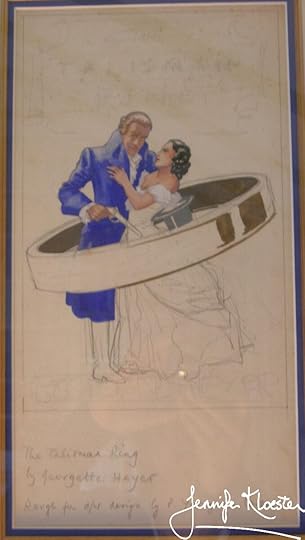 A larger view of the original partially-completed cover art for The Talisman Ring.
A larger view of the original partially-completed cover art for The Talisman Ring.The American edition
I love the Amercian first edition of The Talisman Ring with its colourful cover, gorgeous spine, and melodramatic picture. It depicts the scene in Basil Lavenham’s library where Miss Thane is pretending to be the antithesis of her real self and has adopted the persona of a foolish female. Sir Tristram is on bended knee and appears surprised to see his cousin Basil, who seems to have a rather sickly green hue. Perhaps Basil has realised thy are onto him! the binding depicts the book’s young hero and heroine: Ludovic and Eustacie in a loving embrace. Despite the slight inaccuracies in the library scene it does appear that this time Georgette’s illustrator had a least read the book!
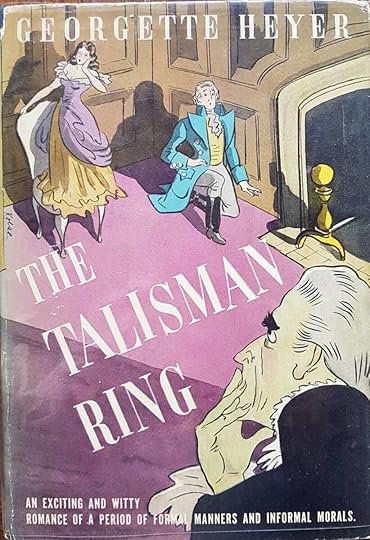 The Talisman Ring was first published in America in 1936 by Doubleday Doran. This is the 1937 US Book League edition.
The Talisman Ring was first published in America in 1936 by Doubleday Doran. This is the 1937 US Book League edition. The delightful binding of the American Book League edition, 1937
The delightful binding of the American Book League edition, 1937Sir Tristram Shield arrives
“Sir Tristram Shield arrives at Lavenham Court in the wintry dusk. Old Sylvester, ninth Baron Lavenham, is dying in splendidly sardonic fully-dressed, fully-powdered style. The cultured reader chuckles. Soon he beams, he’s in for a thriller and detective story in one. And why not? Is the art of detection limited to the Yard and our own dull petrol-stinking period? Horses, smugglers, excisemen, the undeveloped forest that few but the charming and shrewdly innocent Eustacie would have ventured into by night with a couple of band boxes and the intention of catching the London coach and becoming a governess—isn’t all that, and more, a much better field? The characters are not brought on, they come on. Sir Hugh, a great eater but no fool, Sir Tristram, the Beau, that attractive villain, the few female characters wo are so much alive that if Miss Heyer put up any paste-board scenery they would knock it over. The hunt for the Talisman Ring is soon up. The dénouement is neat, extremely neat. It is not, perhaps, our business to say so, but this is Miss Heyer’s twelfth novel at least and has she ever tried to palm the reader off with fustian?”
The blurb from the first edition dustjacket, 1936.
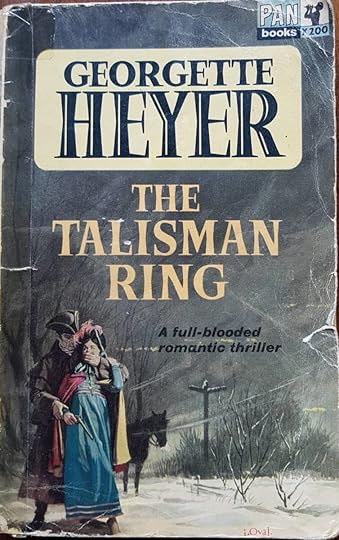 The 6th printing of the 1960 Pan edition
The 6th printing of the 1960 Pan edition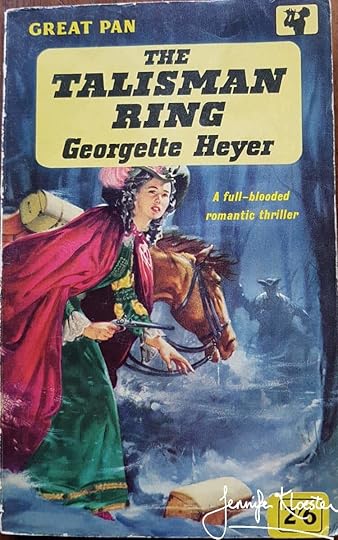 The 2nd printing of the 1960 Great Pan edition
The 2nd printing of the 1960 Great Pan editionOctober 16, 2020
The Talisman Ring – part one
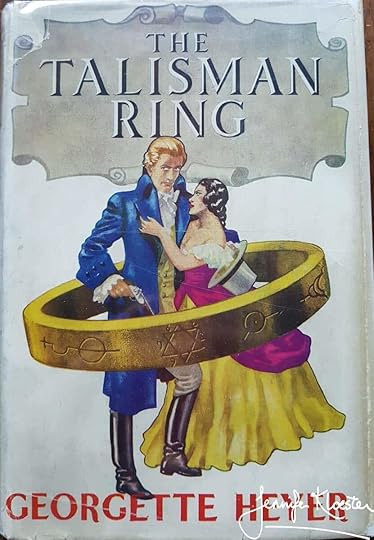 The first edition jacket Heinemann 1936
The first edition jacket Heinemann 1936The Talisman Ring and writer’s block
The Talisman Ring had an unusual birth because for once Georgette Heyer had writer’s block – something that would occur only rarely during her fifty-year career. It was April 1936, she was 33, with a four-old son, and she was still the main family breadwinner. With twenty books already under her belt, this was the first time that she’d felt she’d ‘written herself out’. She had struggled for several days over what to write – whether short stories or a novel called Corinthian – and had almost given up, when, as she told her agent’s assistant, Miss Perriam, “a Wholly Glorious novel burst upon me in the space of twenty minutes”. Three hours work gave her the synopsis and a rough outline of the characters and plot and two months later she’d finished writing The Talisman Ring, one her funniest and most delightful novels.
 The Red Lion Inn at Handcross
The Red Lion Inn at HandcrossThe Talisman Ring set at the Red Lion Inn at Handcross
Georgette set the novel in 1793 in the familiar countryside around Horsham, and much of the story takes place in a country inn – the Red Lion Inn at Hand Cross. She based the fictional inn on the real Red Lion Inn at Handcross on the London to Brighton road, just a few miles to the east of her old home at Southover. The Talisman Ring is one of her ironic comedies and she obviously enjoyed writing it. The novel has a memorable cast of characters including the redoubtable Miss Sarah Thane and her gourmand brother Sir Hugh Thane, the unshakeable Sir Tristram Shield, drama-loving Eustacie de Vauban, reckless young Ludovic Lavenham, and the silken-tongued Basil Lavenham. Georgette also made the most of her shrewd innkeeper, Nye, and a pair of Bow Street Runners whose determination to catch a murderer lead to some of the funniest scenes in the book.
Georgette faces changes and challenges
Heyer face a number of changes and challenges through April and May. Her son Richard, aged four, had become ill and needed an operation, and as Georgette explained, “When worried I find it impossible to write light-hearted adventure”. Richard eventually recovered and she was able to get on with her writing, but there was a major change on the horizon which must also have occupied her mind. After much discussion, Ronald had finally decided to “chuck in the sports store” and read for the Bar.
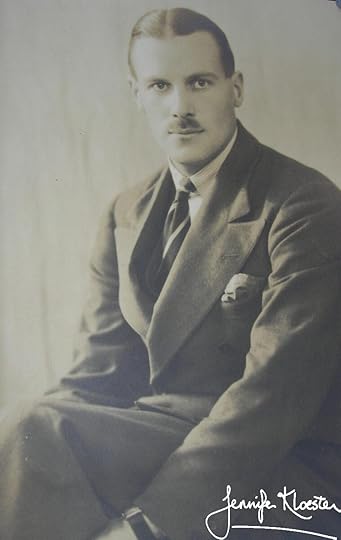 Ronald Rougier in his thirties, about the time he decided to fulfill a long-held ambition and read for the Bar
Ronald Rougier in his thirties, about the time he decided to fulfill a long-held ambition and read for the BarRonald had done his best
Ronald had done his best to make a go of the sports store and contribute to the family coffers, but it had not proved a fulfilling occupation for a man of his experience and ambition. While there were aspects of country living which he enjoyed, the move to Sussex must have been an adjustment, especially after the adventure of the Caucasus, the wide expanses of Africa and the challenge of Macedonia. By the time his son was born in 1932, Ronald had owned the Russell Hillingdon Sports Store for a year, but on Richard’s birth certificate he gave his occupation as ‘mining engineer’ rather than “retailer” or “shop owner”. Despite her worries over bills and where to find the money to pay for their renovations, in 1936 Georgette and Ronald agreed that he should fulfil his long-held ambition and become a barrister.
An expensive undertaking
In England in the 1930s reading for the Bar was expensive. A candidate could not accept briefs or be paid during his three years of training and the system effectively precluded anyone without a private income from becoming a barrister. There were also the costs of admission fees, lecture fees and term dinners, the hire or purchase of a wig and gown, and the expenses of obtaining and keeping a place in an established chambers. Though different today, in the 1930s Ronald was required to seek admission to one of the four Inns of Court and show that he was not engaged in any profession which disqualified him from being called. This meant that, even if he had wished to continue running the sports store, he would have been compelled to give it up because the tradition in the Courts denied entry to ‘any person engaged in trade’. It was an archaic system and one firmly based on class.
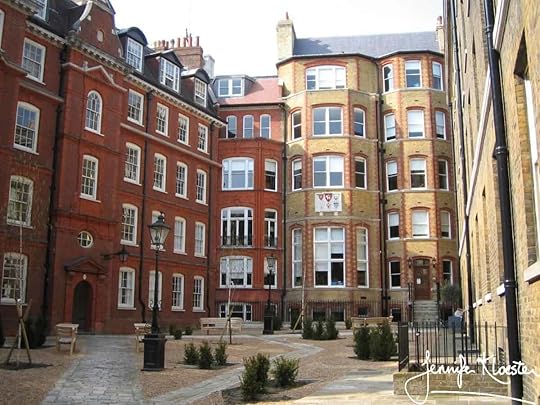 Hare Court, within the Inner Temple, London, https://commons.wikimedia.org/wiki/Fi...
Hare Court, within the Inner Temple, London, https://commons.wikimedia.org/wiki/Fi...The Inner Temple
It cost over £200 to gain admission to the Inner Temple and another £100 once a candidate was called to the Bar. There were four terms a year and it took a minimum of twelve terms to qualify, during which it was necessary to pass Parts I and II of the Bar Examinations. The exams for Part I could be taken at any time after admission but Part II could only be attempted after the successful completion of a minimum of six terms. The Bar student attended regular lectures run by the Council of Legal Education in London and was also required to ‘keep his terms’ by ‘dining a certain number of nights of each term in the Hall of his Inn’. Although this ancient tradition was now little more than a formality it was still considered a necessity and a student dined in Hall on at least six nights in each term. Ronald applied for admission to the Inner Temple in the spring of 1936 and Georgette wrote to Miss Perriam to say ‘If you can think of any way whereby I can raise ready cash by my pen, pray tell me of it!’.
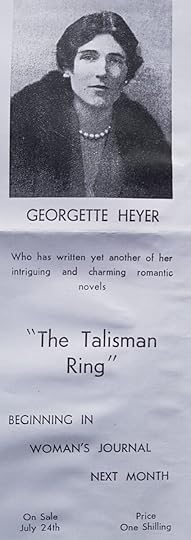 Advertising The Talisman Ring in the July 1936 edition of Woman’s Journal
Advertising The Talisman Ring in the July 1936 edition of Woman’s JournalWoman’s Journal
Only a month before writing The Talisman Ring, Georgette had asked Miss Perriam whether she thought Woman’s Journal would buy a second Regency romance? The magazine was one of Britain’s most successful and a serial sale not only meant a much-needed fee but also increased book sales. Magazine serials always came out a few months before the book’s publication, thereby encouragng readers to order the novel in advance. The serial was meant as a delicious appetiser, designed to entice the reader to buy the book and feast on the unabridged version. The early chapters of The Talisman Ring were clearly enough to convince the Woman’s Journal editor, the formidable MIss Dorothy Sutherland, that the novel would make an excellent serial and by mid-May Georgette had sent through the first instalment.



